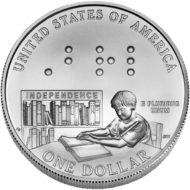When you can’t see a coin, the value has a different meaning. In regular collecting, among many things, the value is determined by the quality of the coin. To me, besides the fact of how much I want a particular coin, the value is in how well I can feel the details.
One of the greatest values for me is that I can touch a coin. If a coin is in a holder or capsule, I have no idea what it is. It may as well be paperweight. If I touch it with gloves to preserve the quality of a coin, it is still not much more than that. Therefore, the more I like a coin, the more I am going to touch it, and the more it will lose from its value. This brings up another discussion about the meaning of going to a coin show, but let that be another post.
There are some quite worn coins where you can still see the details, but sometimes you can’t feel too much. To me, these are not interesting coins. There are other ones, where you can feel the details, but people tell me that the coin is dirty, or unreadable. Usually I have no idea.
It would be great to post a couple of pictures to illustrate, but let’s just say that I have no idea where to start, because generally I don’t know what most of my coins look like, I just know what they feel like. Sometimes I find it interesting that my guess would be that the coin is almost uncirculated, yet people can’t even read the date on it.
And here comes a great advantage of not being able to see: I get the same enjoyment out of a $10 and a $5000 coin. I can buy a coin cheap, or trade lower quality coins with others. When I exchange coins with friends, and they have several of the same type, I do ask them to give me the lower quality one as long as they think they feel the same.
There is also a disadvantage when you can’t see a coin: I can’t just enjoy looking at other people’s coins. It is not fair to touch a coin which others cared for and preserved in great condition. There are so many opportunities to touch a couple of coins that I possibly will never have, but I don’t want to ruin it with my fingerprints. As a general courtesy, I always ask people if I can touch a particular coin. Interestingly, in many coin stores they let me touch the coins, especially the old ones, even if I make it clear at the beginning that I am not buying it.
There is a relatively good solution to feel the details of a coin without touching it. When you put it into a cardboard holder, the thin plastic covers the coin. This plastic is thin enough that it is almost the same experience as touching the coin without the holder. For that matter, a thin plastic tends to bring out different details. For that matter, I keep some of these around, or even a thin plastic bag will do. It is interesting to touch a coin with and without a plastic sheet. Give it a try, you will be surprised.

